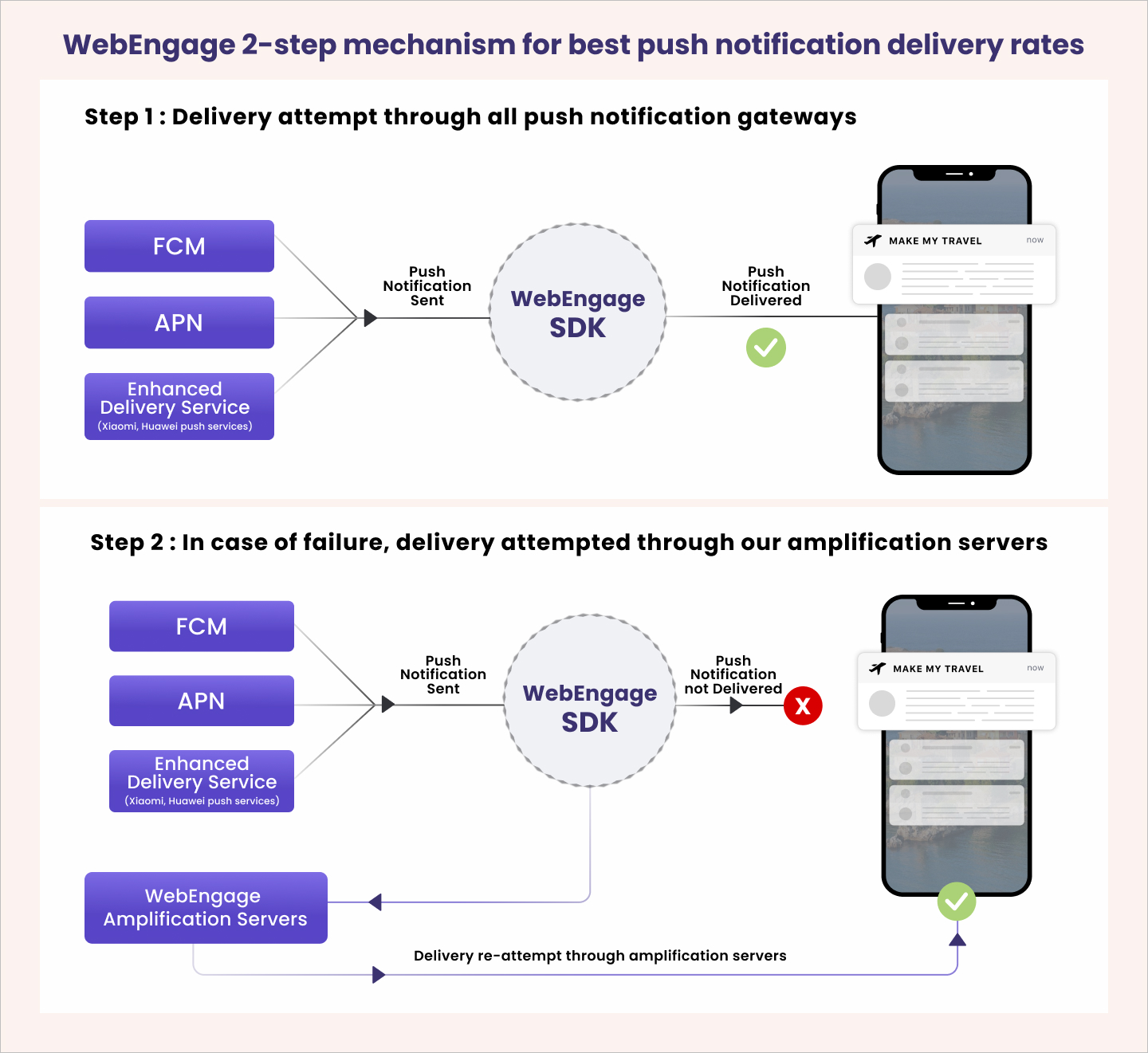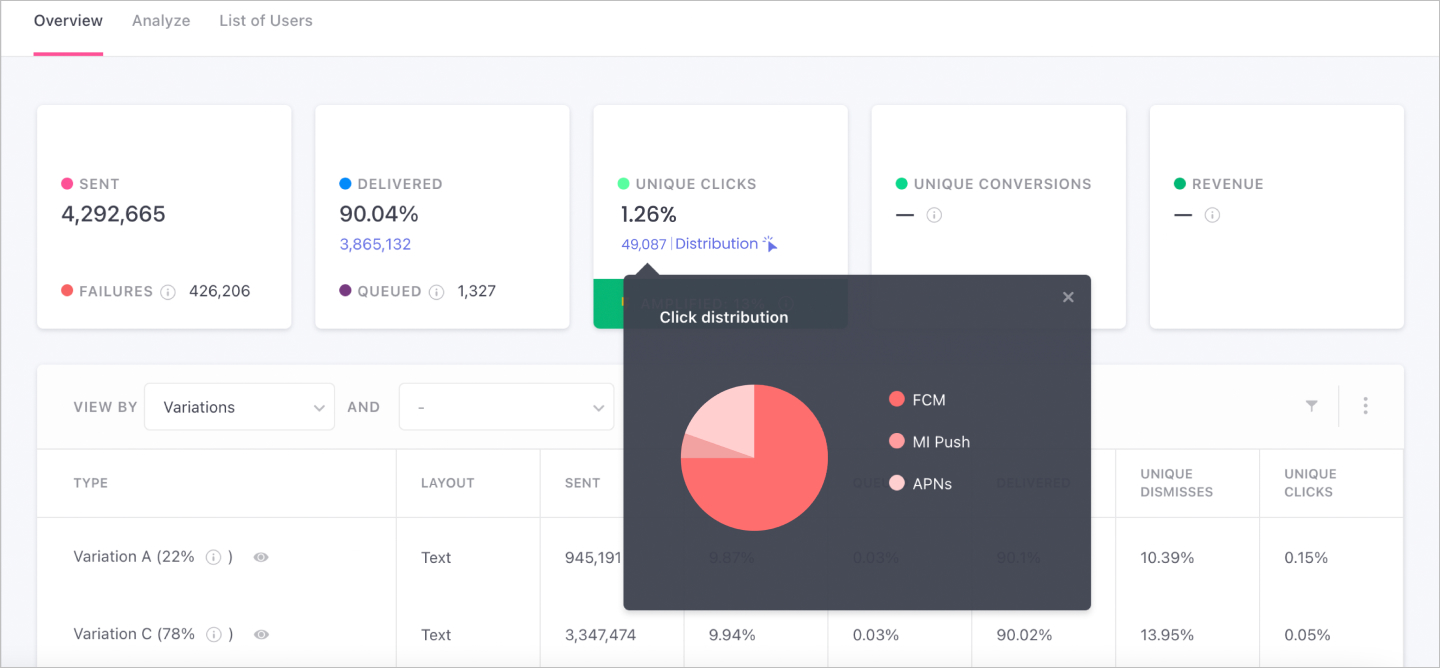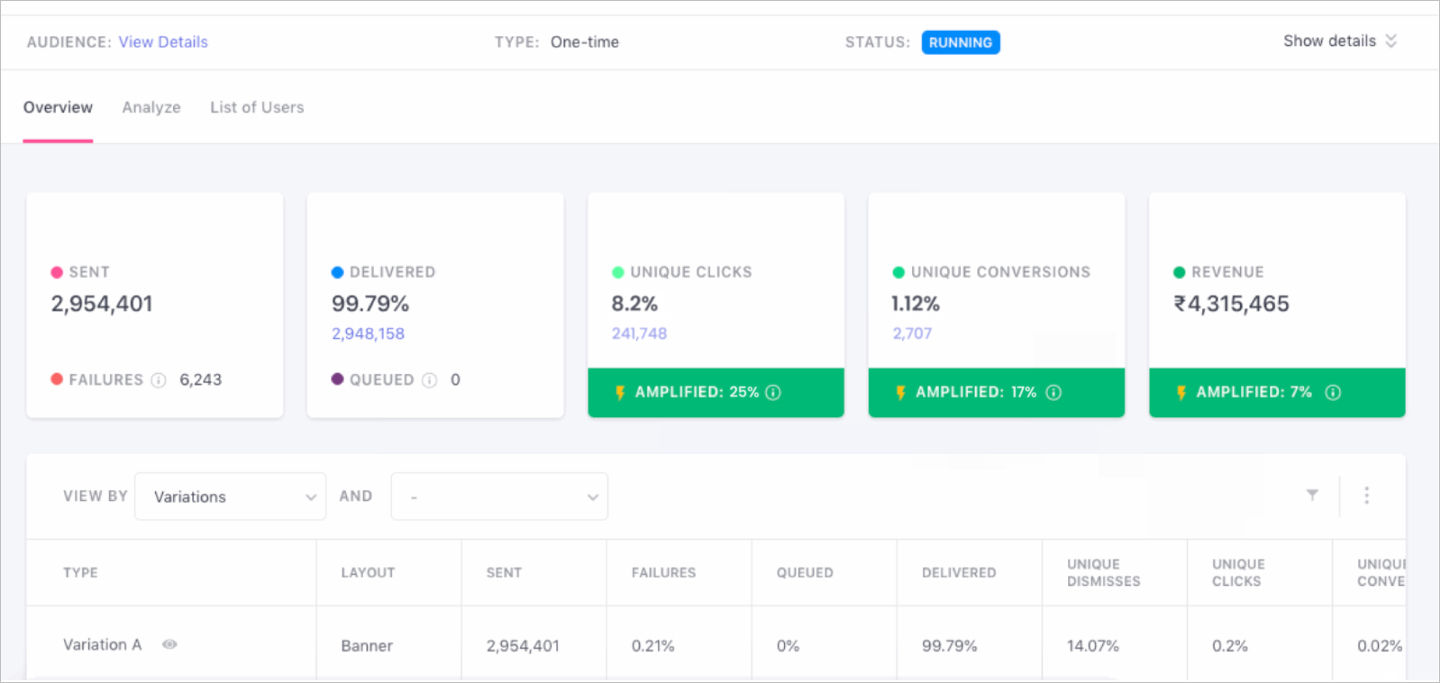Push notifications are essential now, more than ever. For consumers, it is a source of receiving essential information. While for marketers, it is an important communication tool to get users’ attention and engage with users, even when they are not active on the app. According to our latest survey, the volume of push notifications sent in Q1 2021 vs. Q1 2022 has increased by 40%. But here’s a caveat.
With the surge in apps available on the app store or play store, it has become challenging to engage with and retain users on the app. Adding to this obstacle is the problem of ensuring impressions or delivery of push notifications.
Why do Push Notifications fail to get delivered?
Delivery failure can occur because of user inactivity, opt-outs, network issues, and OS/device restrictions. The device-level restrictions ‘kill’ the background processes and restrict FCM/APNs from delivering a push notification, and are persistent mainly in Chinese OEMs, including Xiaomi and Huawei. So no matter how targeted or personalized your campaign, low delivery will yield lower opens and consequently lower conversions, rendering your efforts futile.
So is there a solution?
Introducing Advanced Push by WebEngage
Among the various reasons for delivery failure, one reason we can control and actively improve upon is OS/device level restrictions. This is where our 2-step mechanism ensures maximum impressions for every push notification you send to your users.
Step 1 – Expanding the current push notification delivery mechanism beyond FCM and APNs
Our enhanced delivery support for Xiaomi and Huawei push services helps with just that in the case where device-level restrictions prevent delivery through FCM (Google’s cloud messaging service).
Step 2 – Going the extra mile, ensuring maximum delivery of your push notifications
In case of undelivered push notifications, our system bypasses the traditional route (through FCM) and re-attempts delivery through our amplification servers.
Delivery failure can occur because of user inactivity, opt-outs, network issues, and OS/device restrictions. The device-level restrictions ‘kill’ the background processes and restrict FCM/APNs from delivering a push notification, and are persistent mainly in Chinese OEMs, including Xiaomi and Huawei. So no matter how targeted or personalized your campaign, low delivery will yield lower opens and consequently lower conversions, rendering your efforts futile.
Let’s dive in to understand this better.

The impact of enhanced delivery on Push Notifications
Most push notifications are sent through FCM (Google’s cloud messaging) for Android and through APNs for iOS devices. Integrating Xiaomi and Huawei push services on the WebEngage dashboard can counter the device-level restrictions to ensure maximum delivery of push notifications. The way we help you achieve this is simple. For any push campaign, if the option of enhanced delivery is selected, our system attempts simultaneous delivery through FCM and Xiaomi, and/or Huawei. The simultaneous delivery attempt can uplift the delivery rate by up to 30%. However, we understand that spamming the end-user is not in anyone’s best interest, so we ensure that despite delivery attempts through multiple avenues, users receive the notification only once.
How to leverage enhanced push delivery on the WebEngage dashboard?
We have an added integration for Xiaomi and Huawei push services on the WebEngage dashboard. To get started, update your respective push credentials on the Integrations page. Refer to our developer documents on how to integrate Xiaomi and Huawei push services on your dashboard.
Once the integration is complete, the option to select Xiaomi and Huawei push services becomes available on the Audience tab while creating a push campaign.

Analyzing the impact of enhanced push delivery
You can view the click distribution for each campaign from the unique clicks card under Overview to get a sense of which device contributed the most clicks. Typically, the delivery of push notifications for OEM devices, such as Huawei and Xiaomi, lies anywhere between 30% to 45%.
With our enhanced delivery mechanism, delivery of push notifications can be amplified anywhere between 50% to 75%.
Read our knowledge base for more information on the same.

Augmenting delivery with our amplification servers
Besides expanding device support for Xiaomi and Huawei push services, our system is constantly running in the background for push notifications that still remain undelivered. Our amplification servers attempt delivery for each campaign sent through the WebEngage dashboard. We follow a simple mechanism where our SDK interacts with the server to check and re-attempt delivery to the user’s app.
Think of our amplification servers as a safety net, ensuring that your push notifications land in your user’s inbox, bypassing FCM or enhanced delivery options for undelivered notifications. It can provide upto 30% uplift in clicks and upto 20% uplift in conversions.
YYou can analyze the real-time impact of our amplification efforts on your campaigns through the stats highlighted in green. All you need to do is upgrade/integrate your Android apps with the latest SDK version, and we’ll take care of the rest!

Integrating Xiaomi and Huawei Services for Reliable Notification Delivery
Initially, push services were provided solely by FCM (Firebase Cloud Messaging) and APNS (Apple Push Notification Service). However, with the increasing market share of Chinese OEM devices, companies like Xiaomi, Huawei, and Baidu introduced their own push services to deliver a more optimized user experience on their devices.
Xiaomi, now the third most popular smartphone vendor globally, trailing only Apple and Samsung, commands almost 13 percent of the global smartphone market. This underscores the importance of push notifications in reaching users across a significant portion of the global smartphone user base. However, amidst this widespread adoption, a critical challenge has emerged: the impending deprecation of Mi Push Service.
The Challenge of Mi Push Deprecation
Mi Push, a service relied upon by numerous businesses, faces imminent discontinuation. Many companies turn to FCM as an alternative, but it’s often suppressed by Chinese OEM devices due to battery optimization concerns. Currently, a staggering 40% of delivered push notifications aren’t visible on a user’s device due to inactive app status or battery optimization on Chinese OEM devices.
This reliance on the Mi Push service poses a significant challenge for businesses, as its deprecation could severely impact the effectiveness of their push notification campaigns. Companies that depend on push notification vendors and are overly dependent on Mi Push service will likely see a significant drop in the deliverability of their campaigns, ultimately affecting user engagement, conversion rates, and app retention.
The Complex Landscape of Push Notification Technology
The technology landscape of push notifications is intricate, involving various components that seamlessly interact to deliver timely messages to users’ devices. At its core, push notification technology relies on user registration, where apps connect with push notification services provided by operating systems like Apple’s APNS for iOS and Firebase Cloud Messaging (FCM) for Android.
Upon registration, devices receive unique identifiers (device tokens), facilitating targeted message delivery. However, the rise of Chinese OEM Device Push Services has introduced multiple complexities. These services, driven by battery optimization concerns, often suppress FCM, impacting the delivery of push notifications on devices.
Utilizing Amplification Servers to Boost Push Notification Reach
Push notifications are a reliable and effective way to engage mobile app users. For marketers running engagement or retention programs, maximizing the reach of their campaigns is crucial.
However, a significant challenge arises, particularly on Android devices, where 40-70% of users may never receive these notifications. This is where amplification servers come into play, offering a powerful solution to improve push notification delivery and ensure your messages reach a wider audience.
The Challenge of Push Notification Delivery
Traditionally, push notifications are served through delivery gateways such as Firebase Cloud Messaging (FCM) for Android and Apple Push Notification Service (APNs) for iOS. While these services are generally reliable, they face certain limitations, especially on Android devices.
The primary obstacles to successful push notification delivery include:
How Amplification Servers Enhance Delivery
Push amplification servers act as a safety net, catching notifications that fail to deliver through traditional channels. Here’s how they work:
Wrapping Up
Advanced push can help you reach a wider audience bypassing the issue of a failed delivery. We hope you make the most of this feature and share your feedback. If you need more assistance, get in touch with your Customer Success Manager or reach out to product@webengage.com to get started.
FAQ
What is Advanced Push Notification Delivery?
Advanced Push Notification Delivery is a sophisticated approach to sending push notifications that leverages multiple delivery channels and intelligent routing.
It combines traditional methods like FCM with OEM-specific services and amplification servers to maximize delivery rates. This system adapts to device restrictions, network conditions, and user settings to ensure notifications reach users more consistently and effectively.
How can advanced push notification delivery improve campaign effectiveness?
Advanced push delivery significantly boosts campaign effectiveness by increasing delivery rates. It bypasses device restrictions and network issues, ensuring more users receive your messages.
This higher reach translates to improved engagement rates, better conversion rates, and, ultimately, a stronger ROI for your marketing campaigns. It also provides more accurate analytics for campaign optimization.
What are the challenges in push notification delivery, and how can they be overcome?
Key challenges include device-level restrictions (especially on Chinese OEMs), network connectivity issues, and user settings that block notifications.
Advanced delivery overcomes these by using multiple delivery channels, including OEM-specific services and amplification servers. It also employs intelligent routing to choose the best delivery method for each user, significantly improving delivery rates and overcoming device-specific obstacles.
How do Xiaomi and Huawei push services enhance notification delivery?
Xiaomi and Huawei push services bypass the restrictions these OEMs place on background processes and FCM. By integrating these services, notifications can be delivered directly through the manufacturer’s system, avoiding suppression due to battery optimization.
This significantly improves delivery rates on these popular devices, which make up a substantial portion of the global smartphone market.
What role do amplification servers play in push notification campaigns?
Amplification servers act as a safety net for push notifications. When traditional delivery methods fail, these servers detect the failure and attempt re-delivery through alternative channels.
They bypass device restrictions and network issues, significantly boosting delivery rates. This ensures that more of your audience receives your messages, enhancing the overall effectiveness of your push notification campaigns.
What are the benefits of integrating Xiaomi and Huawei Push Services?
Integrating Xiaomi and Huawei push services offers several benefits:








 Harshita Lal
Harshita Lal
 Sanjay Mishra
Sanjay Mishra